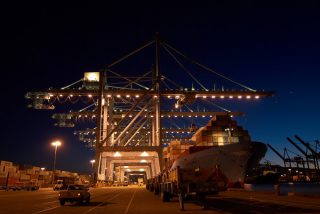SoCal Ports Keeping Tabs on Maersk Boxship Retrofits
SoCal Ports Keeping Tabs on Maersk Boxship Retrofits

Danish shipping giant Maersk Line and the US ports of Los Angeles and Long Beach have partnered to measure the environmental benefits of a USD 125 million upgrade for 12 Maersk container ships.
The project, entitled “The Connected Vessel Programme”, will include the installation of high-tech equipment to track vessel emissions and energy efficiency over the next three years.
The equipment is expected to enable more transparency and ultimately reduce the environmental impact of vessels calling at the San Pedro Bay port complex, Maersk Line said.
Under their joint Technology Advancement Program (TAP), the two ports are contributing a combined USD 1 million to real-time tracking systems aimed at pinpointing vessel emissions while ships are at sea and at berth.
The project will continuously record how much fuel each engine uses in conjunction with speed, engine power, weather and other operational variables through use of mass flow meters and an interface to the Integrated Control System (ICS) on-board to capture key performance data, Maersk Line said.
Information will be uploaded to Maersk Line servers via satellite, and each ship will be able to communicate in real-time with Maersk Line’s Global Vessel Performance Centre (GVPC) to increase operational efficiency.
“This is the equivalent of strapping a Fitbit onto a large container ship. We’ll be tracking vessel performance and emissions 24/7. This advances our ability to reduce greenhouse gasses and other pollutants on a global scale,” Lee Kindberg, Director of Environment and Sustainability for Maersk Line, said.
The project builds on the USD 125 million Maersk Line has invested in its “radical retrofit” program to reduce fuel consumption and increase the capacity of the vessels that regularly call at the San Pedro Bay ports.
Under its “radical retrofit” program, Maersk Line upgraded vessels that already plug into shore power at the San Pedro Bay ports. The additional improvements include redesigning the bulbous bow of each vessel, replacing existing propellers with more efficient models, and “derating” the main engines to make them more efficient at lower speeds.
The retrofit program also involved raising the bridge to increase each ship’s capacity from about 9,500 TEUs to about 11,000 TEUs. This allows Maersk Line to carry more containers per vessel while decreasing their environmental impact per container moved.
According to Maersk Line, the energy efficiency makeover is expected to decrease each ship’s fuel consumption by more than 10 percent, saving an estimated 10,000 metric tons of fuel on an annual basis. This would reduce greenhouse gas (GHG) emissions by an estimated 31,000 tons of carbon dioxide (CO2) per year and lead to similar reductions of diesel particulate matter (DPM), nitrogen oxides (NOx) and sulfur oxides (SOx).
Maersk Line said that the retrofits and TAP demonstration project with the two ports will help the company reach its goal of a 60 percent reduction of CO2 and other pollutants by 2020.
HEADLINES
- Do shipping markets want Biden or Trump for the win?
- All 18 crew safe after fire on Japanese-owned tanker off Singapore
- Singapore launching $44m co-investment initiative for maritime tech start-ups
- Cosco debuts Global Shipping Industry Chain Cooperation Initiative
- US warns of more shipping sanctions
- China continues seaport consolidation as Dalian offer goes unconditional